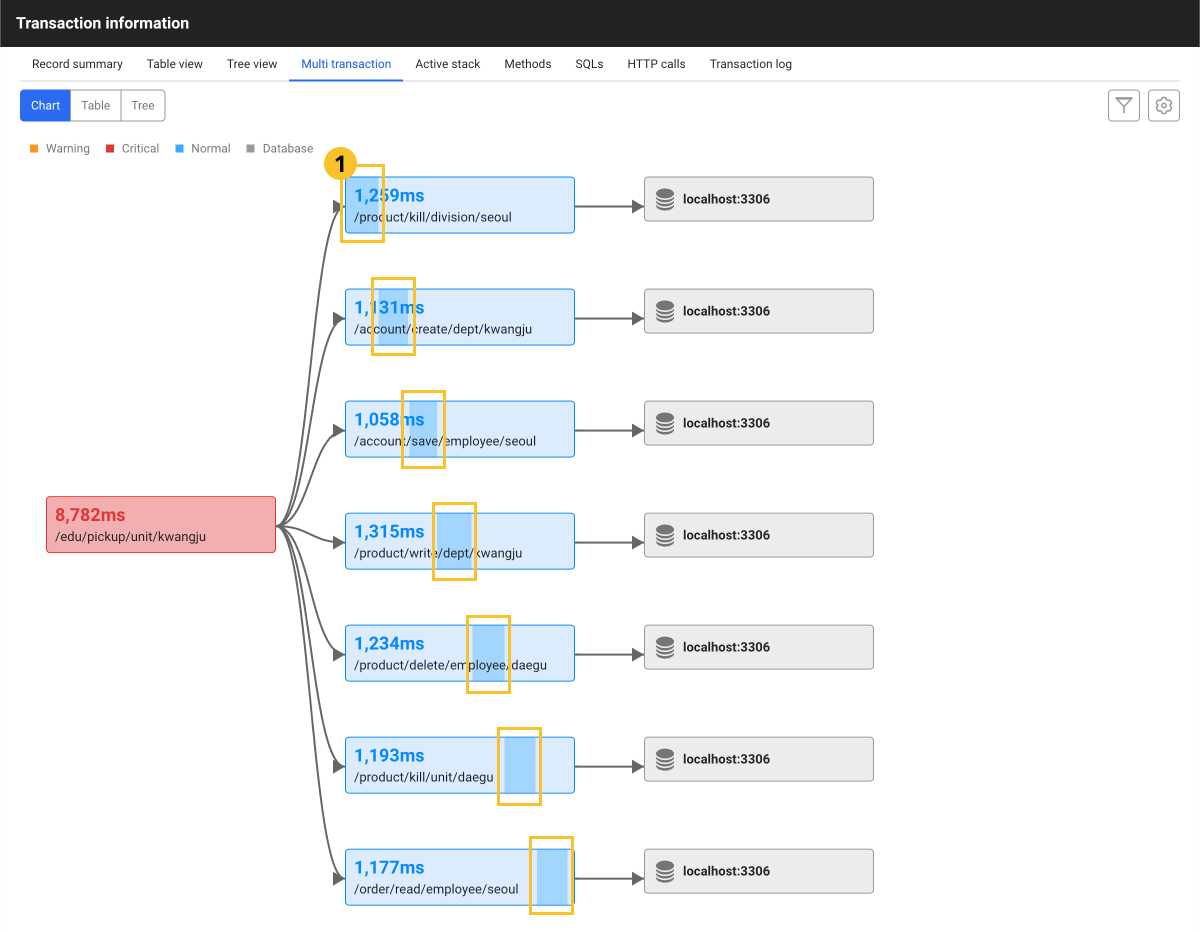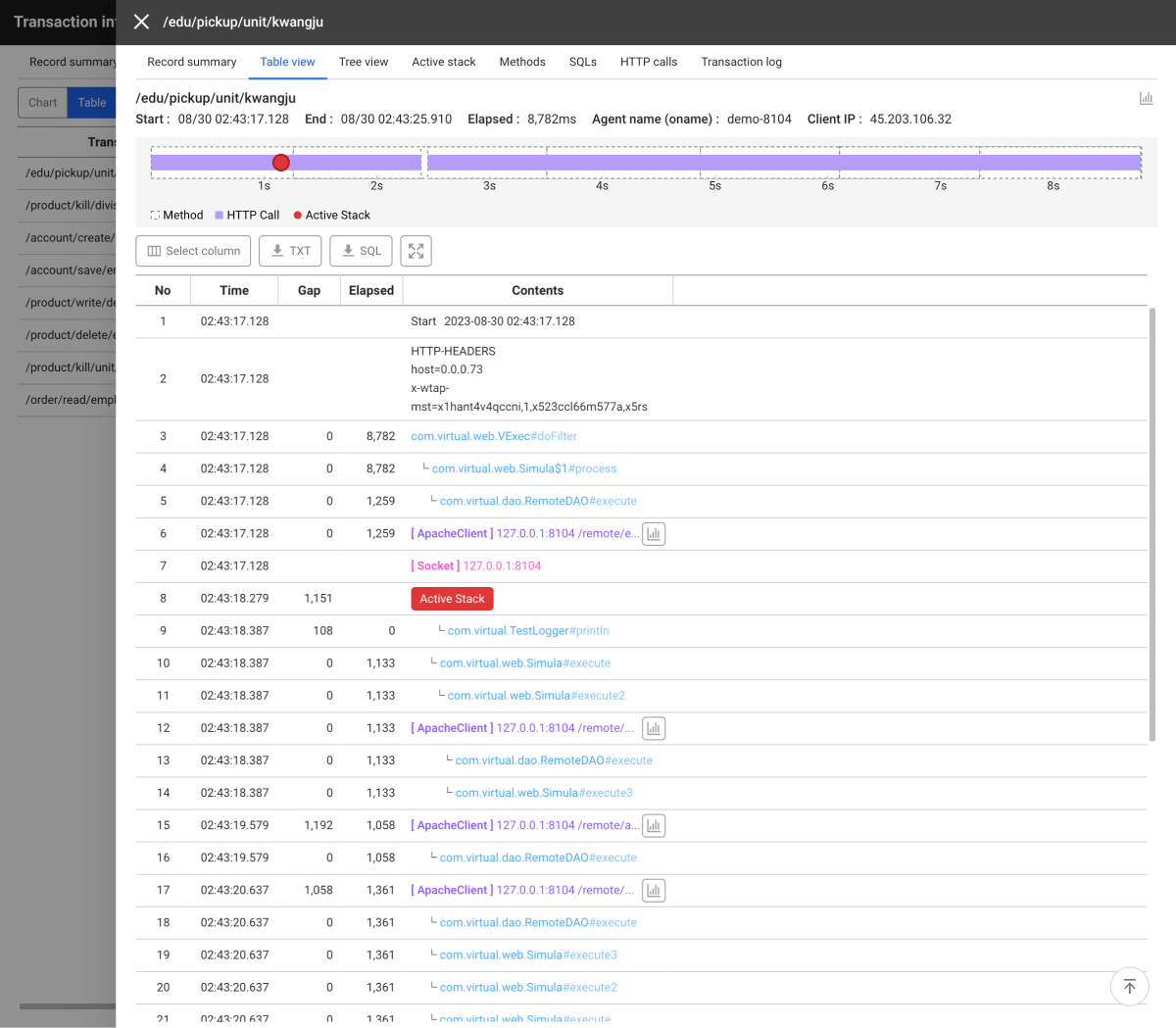Multi-transaction
Multi-transaction means the transaction involving a different agent or project. Multiple Transaction Trace is to trace calls between the application services registered in the WhaTap project.
Enabling the multi-transaction
To trace multiple transactions, set the mtrace_enabled option to true in Management > Agent CONF.. For more information about the agent configuration, see the following.
Multiple transaction trace
Drag the chart area in Home > Select Project > Analysis > Hitmap. The transaction information of the dragged chart area appears in the TX trace list at the bottom. Transactions including multi-transactions in the list are marked with the icon.

When you select the trace, the Transaction information window appears. If multi-transactions are being traced, you can see the Multi transaction ID in the Record summary tab. Even if you make an outbound call in transaction, the same Multi transaction ID is generated. If projects are separated by service, all transactions between applications can be verified through the first issued Multi transaction ID. For more information about the detailed analysis of TX traces using the Transaction information window, see the following.

If you select Multi transaction ID, the Multi transaction tab appears. The transactions and trace data are provided so that you can see various call relationships at a glance within or between systems, and identify where problems occurred for improvement.
Chart

The default screen for Multi transaction is Chart. Chart clearly provides you with call relationships for each transaction. You can check individual execution times for transaction services with the same Multi transaction ID. You can see the call relationships between transactions through the step times ( Time Bar) expressed in background colors for transaction nodes. In the Chart, you can use the mouse to move to a desired position or zoom in or out by scrolling.
-
Project selection: You can select or deselect projects to be displayed on the chart.
-
Chart view settings: You can display or hide the elements on the chart.
-
Time Bar: You can display or hide the step times (Time Bar) for each node.
-
Application Name: You can display or hide the agent names (oname) for each node.
-
Project: You can display or hide the project names for each node.
-
Database / External / Internal: Connection requests for other databases or HTTP calls that occurred in the transaction can also be viewed through the nodes of the chart.
-
If you select a transaction node, an additional Transaction information window appears as follows. The transaction trace allows you to see the transaction details. For more information about the detailed analysis of transaction trace through the Transaction information window, see the following.

Table
If you click Table, in the form of table, you can see the data for each transaction included in multi-transactions.

-
Project selection: You can select or deselect projects to be displayed on the chart.
-
Column Settings: You can edit the columns in the table.
When you select each transaction, the Transaction information window for the selected transaction appears, similar to selecting a node in the Chart tab. You can see the details of the transaction through the transaction trace. For more information about the detailed analysis of transaction traces using the Transaction information window, see the following.
Tree
If you select Tree, you can see the detailed information for each transaction and their traces. The transactions within the overall transaction time or start times and step times of each trace to provide transaction call relationships in a tree format.

-
Project selection: You can select or deselect projects to be displayed on the chart.
-
Single-line View: You can arrange the tree format at intervals by displaying the texts displayed in the execution data for each section in a single line.
-
Multi-line View: All the texts displayed in the execution data for each section, appear by wrapping words.
-
Longest Path: The longest route can appear.
-
Show Time Bar: The elapsed times are displayed in a bar chart.
-
Show Time: The timestamps, gaps, and elapsed times for each segment are displayed in text.
-
8 seconds or more: Excessive delay state is distinguished in red.
-
Between 3 and 8 seconds: Delay state is distinguished in orange.
-
Less than 3 seconds: Normal state is distinguished in blue.
NoteIn case of start and step times, the time differences caused by the transaction call environment are corrected on the screen through traces and mappings in the parent transactions. Accordingly, there may be differences from the actual time data.
-
-
Hide Time: The time is hidden.
-
When you select
or
of the trace, you can see the detailed information such as HTTP call statistics, Active stack and SQL.
-
By selecting
of an SQL step, you can copy the SQL statement of the step.